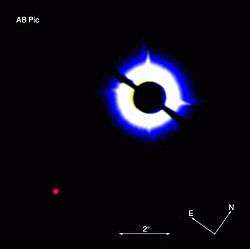AB Pictoris
 Coronagraphic image of AB Pictoris showing its tiny companion (bottom left). The data was obtained on 16 March 2003 with NACO on the VLT, using a 1.4 arcsec occulting mask on top of AB Pictoris. | |
| Observation data Epoch J2000.0 Equinox J2000.0 (ICRS) | |
|---|---|
| Constellation | Pictor |
| Right ascension | 06h 19m 12.9135s[1] |
| Declination | −58° 03′ 15.522″[1] |
| Apparent magnitude (V) | 9.16[1] |
| Characteristics | |
| Spectral type | K2V[1] |
| B−V color index | 0.8[1] |
| Variable type | BY[2] |
| Astrometry | |
| Radial velocity (Rv) | 22.2 ± 0.3[1] km/s |
| Proper motion (μ) | RA: 14.13[1] mas/yr Dec.: 45.21[1] mas/yr |
| Parallax (π) | 21.97 ± 0.82[1] mas |
| Distance | 148 ± 6 ly (46 ± 2 pc) |
| Absolute magnitude (MV) | 5.87[3] |
| Details | |
| Temperature | 4800[4] K |
| Metallicity | [Fe/H] = −0.64[4] |
| Rotational velocity (v sin i) | 12[4] km/s |
| Age | 3 × 107 to 4 × 107 [5] years |
| Other designations | |
| Database references | |
| SIMBAD | data |
AB Pictoris (abbreviated AB Pic, also catalogued as HD 44627) is a K-type star, approximately 148 light-years away in the constellation of Pictor.[1] It has been identified as a member of the young (30 million years old) Tucana–Horologium association.[6] The star has also been classified as a BY Draconis variable.[2] In 2005 it was announced that an astronomical object (AB Pictoris b, abbreviated AB Pic b) had been imaged in 2003 and 2004 close to and apparently in orbit around the star. Its mass suggests that it is at the borderline between being a brown dwarf or a planet.[7]
Possible planetary system
In 2003 and 2004, an object (now catalogued as AB Pictoris b) was observed close to the star by a team of astronomers at the European Southern Observatory. Since it had common proper motion with AB Pictoris, it was concluded that it was physically close to the star. Its spectral type was estimated as between L0V and L3V. Using evolutionary models, its mass was estimated as from 13 to 14 Jupiter masses.[7] However, because modelling such young objects is difficult, this estimate is very uncertain; some models give masses as low as 11 Jupiter masses or as high as 70 Jupiter masses. Temperature estimates range from 1600 K to 2400 K.[5] As it is not known if the mass of the object exceeds the deuterium burning limit of 13 Jupiter masses, it is not clear whether the object should be classified as an extrasolar planet or a brown dwarf.[7]
| Companion | Mass | Observed separation (AU) | Discovery year |
| b | 13.5 ± 0.5[8] MJ | 275[8] | 2005[8] |
See also
References
- 1 2 3 4 5 6 7 8 9 10 11 "V* AB Pic". SIMBAD. Centre de données astronomiques de Strasbourg. Retrieved October 3, 2008.
- 1 2 AB Pic, database entry, The combined table of GCVS Vols I-III and NL 67-78 with improved coordinates, General Catalogue of Variable Stars, Sternberg Astronomical Institute, Moscow, Russia. Accessed on line October 3, 2008.
- ↑ From apparent magnitude and parallax.
- 1 2 3 HD 44627, database entry, The Geneva-Copenhagen Survey of Solar neighbourhood, J. Holmberg et al., 2007, CDS ID V/117A. Accessed on line November 19, 2008.
- 1 2 Homogeneous comparison of directly detected planet candidates: GQ Lup, 2M1207, AB Pic, Ralph Neuhaeuser, ESO Workshop Proceedings on Multiple Stars, Bibcode: 2005astro.ph..9906N, arXiv:astro-ph/0509906.
- ↑ New Members of the TW Hydrae Association, β Pictoris Moving Group, and Tucana/Horologium Association, Inseok Song, B. Zuckerman, and M. S. Bessell, The Astrophysical Journal 599, #1 (December 2003), pp. 342–350, Bibcode: 2003ApJ...599..342S, doi:10.1086/379194.
- 1 2 3 A companion to AB Pic at the planet/brown dwarf boundary, G. Chauvin, A.-M. Lagrange, B. Zuckerman, C. Dumas, D. Mouillet, I. Song, J.-L. Beuzit, P. Lowrance, and M. S. Bessell, Astronomy and Astrophysics 438, #3 (August 2005), pp. L29–L32, Bibcode: 2005A&A...438L..29C, doi:10.1051/0004-6361:200500111, arXiv:astro-ph/0504658.
- 1 2 3 Jean Schneider (2011). "Notes for Planet AB Pic b". Extrasolar Planets Encyclopaedia. Retrieved 12 October 2011.
External links
- Jean Schneider (2011). "Notes for star AB Pic". Extrasolar Planets Encyclopaedia. Retrieved 12 October 2011.
- Homogeneous comparison of directly detected planet candidates: GQ Lup, 2M1207, AB Pic, Ralph Neuhaeuser, ESO Workshop Proceedings on Multiple Stars, Bibcode: 2005astro.ph..9906N, arXiv:astro-ph/0509906.
- "Yes, it is the Image of an Exoplanet". European Southern Observatory. 2005-04-30. Archived from the original on 2008-06-13. Retrieved 2008-07-01.